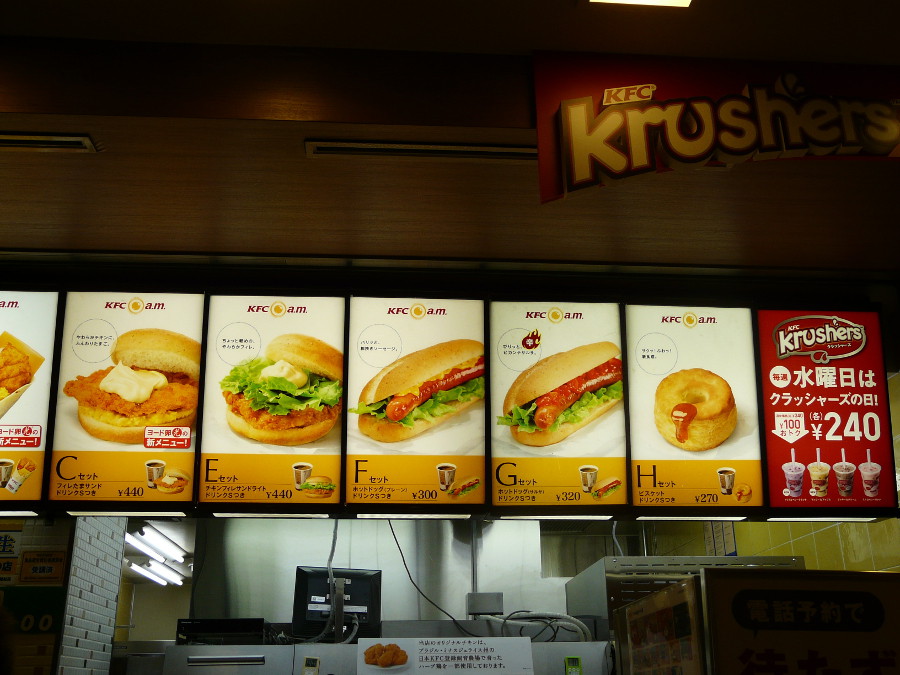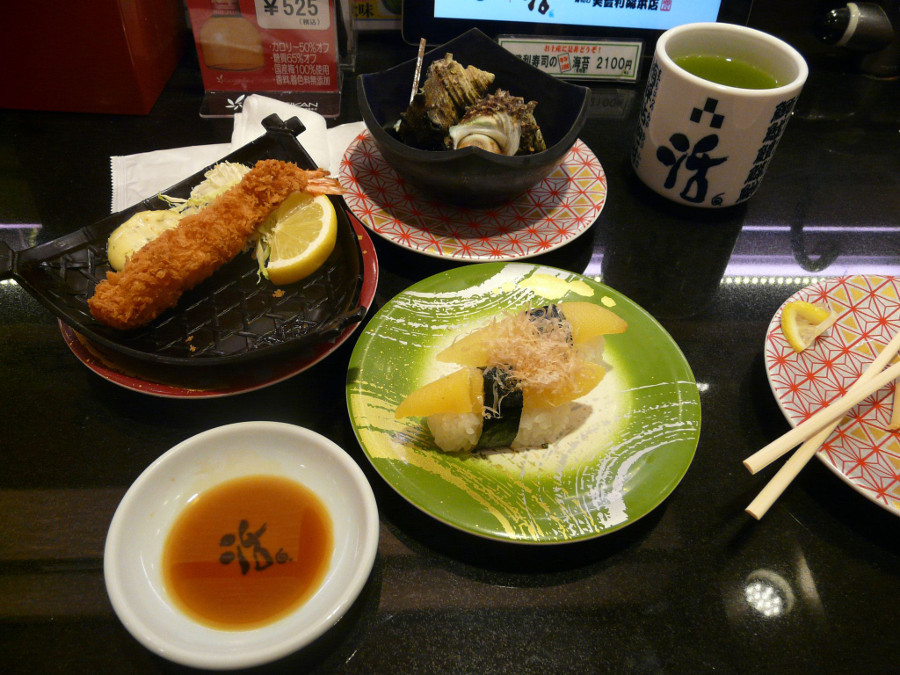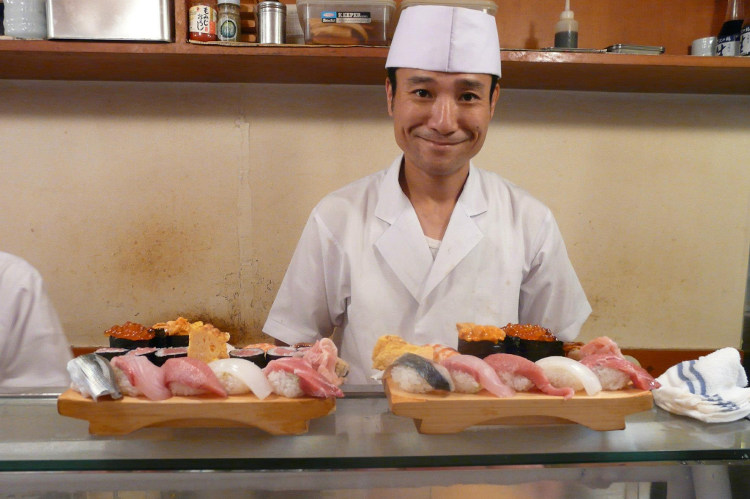When I visit a country, I like to know how does it taste like. Typically, before traveling, I obtain knowledge about the typical delicacies of the culture I am about to visit. When I am there already, I visit the restaurants, pubs, street stalls or even grocery stores. Although I did not find any Japanese crazy-flavored KitKat’s limited edition, the Country of the Rising Sun is full of many other goodies. About some of them I have already told you, like about the grean tea and sweet potato flavored ice cream or the chunko soup. However, please be aware that this is only the tip of the iceberg, which I have not yet seen in full 😉

KFC – not exactly the same as in Europe 🙂
What can you find at the grocery store?
I was captivated the most by the giant roasted corn and “never-ending” puffs. In addition, in the store one can find a big gamma of sweet bread with cream filling, tiny yoghurts or unusual drinks. Of them all I advise you to beware of the coffee – I really did not like it. Nevertheless, my husband recommends trying Green Tea Latte 🙂 Opinions are divided 🙂 However, be careful, because in the shop’s assortment are available both coffee and tea with milk, in a similar packaging, so it is easy to confuse them.
In addition, many stores offer takeaway food that is fairly cheaply priced plus is quite tasty. These include not only sushi but also warm dishes. Besides, the rest of the products rather not differ from the European standards.
 Very tasty octopus available in many grocery stores
Very tasty octopus available in many grocery storesA cooked breakfast
Personally, I recommend for breakfast udon, soba or ramen. Those are very similar to each other soups. The thing that they differ with is mainly pastas, from which those soups received their names. In addition, to the ramen is added pork and egg, while the udon and soba have rather fried seafood. Standard additions to these soups are vegetables. Most additives are ordered at the counter, and paid. The free of charge additives to the soups are available near the counter, but on the client’s side. Many Japanese come in the morning to eat in these fast food restaurants, which usually specialize in making one of these soups. You can eat cheaply and well, and, as those small restaurants are often family businesses, does not need to worry about the food’s quality. After all, a satisfied customer returns 🙂
 Udon noodles are very thick
Udon noodles are very thickHow to eat udon?
Do not be too surprised if you feel the smell of a hog in a good ramen restaurant. At the beginning I felt uncomfortable with this new, unexpected sensation, but as soon as they brought me a bowl of soup I completely forgot about the smell. When you eat, do not be ashamed or slurp – everybody does it. Also, usually as first people eat pasta and add-ons with soup, and the broth is being drunk at the end. But this is not a fixed rule, that can not be broken. Watch out for your shirt, because it is not difficult to make a broth-stain, especially if you’re experienced in eating noodles with chopsticks. For beginners thinner and lighter pasta like ramen or soba would be easier to eat than the heavy and thick udon noodles. Moreover, be warned that soups are served almost boiling, so I advise those unaccustomed to the hot dishes to wait a bit until the soup cools.

Ramen – although it is a relatively new invention, it is one of those dishes without which I am unable to imagine Japan
One can also eat cold soba and udon noodles – with soy sauce, leeks and wasabi.
Sushi bars
Contrary to the popular opinion, the Japanese eat not only sushi. Yes, sushi bars are still popular, and the best ones have several months’ queues (so check whether or not you should make a reservation in advance). Sometimes they also require making a reservation fee.
Often, if the sushi bar is large, servings of sushi will be placed on a moving belt, from which you can take what your heart desires. These bars are called kaiten sushi. Sometimes there are two belts – one for orders, one for dishes that can be taken without ordering. It also happens that the role of the other belt is taken care of by waiters. Agile sushimasters are working behind the belts, and it is possible to look at their hands while they prepare sushi. In some bars in the preparation of sushi portions are shouted “advertises” on the daily specialities.

Sushi bars offer not only sushi made with raw fish. I especially recommend the shrimps in tempura 🙂
In addition to sushi, you can eat sashimi (raw chunks of seafood and fish) or sushi with grilled fish or fried fish or omelette. I liked it that many sushi bars had unlimited access to green tea for free. A standard in Japanese restaurants is that there is no extra charge for at least water.

Sashimi made of mackerel

Very often in front of restaurants one can find a cabinet with artificial models of dishes that are served there. Most of these models are specially ordered, and always match the original.
DIY Restaurants
For me, being a guest at these restaurants was a great experience!
Our first encounter with the Japanese DIY restaurant was with takoyaki and okonomiyaki. The first is a ball of dough that hides in its interior a piece of octopus plus some veggies. Okonomiyaki pancakes are made of different components, where the base is cabbage shreds. When we sat down at our table in the restaurant, we were quickly given the ingredients for both dishes. The waiter turned on the stove for us. “The stove was consisting of large slabs and a piece molds for takoyaki, which were in the corner of the table. At our disposal was also given a skewer (tool required to rotate round takoyaki) and a spatula for okonomiyaki. Apparently, the waiter sensed that we are gaijins, because he often checked how we’re doing. Unfortunately, we were not good at making takoyaki as it usually happens so on the first try. The waiter helped us, gave instruction, and the second portion we have already done ourselves . With okonomiyaki it went much easier. In the end, pies and pancakes are well known to us 🙂
Takoyaki requires good manual skills 🙂 [PL]
Shabu shabu also surprised us. We entered the restaurant and we took our seats. With the waitress we communicated in body language, but eventually agreed upon the meal. When she came with a pot and put it on an induction in the middle of the table, we began to suspect that it will be something absolutely new for us. Afterwards, the waitress gave us meat, vegetables and mushrooms. Our faces apparently had a stupid expression, because sitting next to us young Japanese noticed that something is off, and began to explain to us how we should prepare our shabu shabu.
First of all, you need to wait for the broth to boil, then reduce the heat so it will not boil too rapidly. Then add to it the vegetables and mushrooms, because they need more time to get cooked than meat. Meat, sliced into very thin slices, should be soaked for a few seconds in boiling broth – after that it is ready to eat. In addition to all these, you will get different sauces. You can purchase the “all you can eat” option with the chosen meat type (which determines the price of the package), or ask for individual things and pay at the end. I strongly recommend trying shabu shabu! 🙂
Shabu shabu – Manual [PL] (sesame sauce is delicious!)
Speaking of “all you can eat” restaurant options, it should be added that Japanese pubs offer the option “all you can drink”, which is often chosen by the partying Japanese. How you can spend the evening with friends in Japan, I will tell you next Tuesday 🙂

Enthusiasts of European cuisine can also find something good to eat in Japan…
Useful links:

